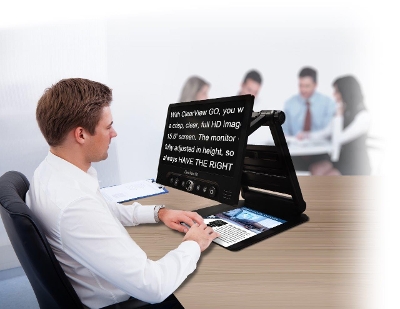Though the Americans with Disabilities Act (ADA) does not list by name all the disabilities or impairments it was created to protect, its purpose is to ensure the rights of individuals who have a “physical or mental impairment that substantially limits one or more major life activities, a person who has a history or record of such an impairment, or a person who is perceived by others as having such an impairment.” (ADA)
Low vision is a visual impairment that cannot be fully corrected with regular eyeglasses, contact lenses, medication or surgery. Despite all conventional treatment, vision remains blurred or distorted, and it interferes with the ability to perform everyday activities such as reading, writing, and shopping. Millions of Americans lose some of their vision every year due to a variety of eye conditions such as Diabetic Retinopathy, Glaucoma, Macular Degeneration or Retinitis Pigmentosa.
Since low vision encompasses such a wide variety of eye diseases and conditions, there is no one-size-fits-all solution or accommodation that is required by the ADA. The amount of usable vision a person has and what their job entails will determine what solution will fit the individual and their needs.
Reasonable accommodations may include, but are not limited to:
- Desktop video magnifiers for writing or signing documents and reading printed text
- Portable video magnifiers for reading printed text or viewing equipment controls and labels
- Large print or Braille printed materials
- Forms and documents in an electronic format
- Refreshable Braille display
- Software that will read or magnify what is on a computer monitor
- Website or apps that are accessible for the blind and vision impaired

equesting a reasonable accommodation may be as simple as submitting the request to your employer. To determine the best solution, the employee and employer may need to discuss the job requirements and what the employee will need to complete their tasks.
How inclusive is your business?
Have you reviewed your recruiting practices to ensure they are not excluding those with disabilities? Look at how you talk about disability in your workplace. Awareness and diversity in conversations will help you build better products. Hiring people with disabilities will not only provide you with qualified individuals but also employees who are reliable, more likely to stay at the job longer, and promote creativity and thinking outside the box throughout the office.
Sources:
Top 5 Benefits of Hiring People with Disabilities, Chicago Lighthouse, October 6, 2016
Blindness and Vision Impairments in the Workplace and ADA, EEOC, May 7, 2014
A Guide to Disability Rights Laws, ADA, February 2020
Jul 21, 2020


